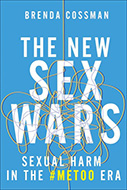The New Sex Wars: Sexual Harm in the #MeToo Era

Author: Brenda Cossman
Publisher: NYU Press, 2021. 280 pages.
Reviewer: Linnea Wegerstad | December 2022
Let me begin this review of Brenda Cossman’s The New Sex Wars: Sexual Harm in the #MeTooEra with its concluding sentence: “We can hold the insights of the sex wars, then and now, beside each other, as we reimagine the kind of reparative and affective justice that law could deliver” (p. 206). The sentence neatly captures this book’s rich content. First, it draws out contestations and similarities between sex wars then and now, then it uses insights from this analysis in a ‘reading beside’ exercise on #MeToo related controversies, with the aim to decenter criminal law and provide room for other kinds of justice responses to sexual harm.
The Introduction chapter lays out the argument. The purpose is to “provide an in-depth and critical analysis of the contemporary regulation of sexual-harm debates” (p. 3). These debates are described in the terms of wars, where the old sex war was about pornography and prostitution and the new sex war concerns sexual harassment, sexual assault, sexting, revenge porn and polygamy, and, again, sex work. The purpose is also to pay particular attention to how law figures in these wars. Cossman asserts from the outset that both sides have tended to fetishize criminal law, either as a problem of under-criminalization or over-criminalization of sex. The analysis is foremost concerned with mapping social justice movements’ engagement with law, not to argue for a particular position. To choose material for the analysis of sex wars now and then, Cossman uses the framework of ‘feminist flashpoints,’ described as “media events that, at once, open up and constrain our thinking about feminist futures” (p. 12) (quoting Sarah Banet-Weiser). In addition, Cossman uses the method of reparative reading inspired by Eve Kosofsky Sedgwick. This method involves “reading beside,” which means accepting the truth claims of both sides and holding them beside one another, in tension (p. 144). This kind of reading aims at moving beyond the trench warfare and find new ways of imagining justice responses to sexual harm.
Chapter 1 sets the scene by carefully outlining feminist debates related to #MeToo. Cossman clearly shows how the generation metaphor enters feminist debates and concludes that it “distorts both the historical and the intellectual continuities and discontinuities” (p. 41). Cossman does not suggest that generational experience is not relevant but argues that the generational narrative alone is limiting. Next, Chapter 2 describes feminist sex wars then and now, paying particular attention to debates about the role of law. As Cossman states, this aspect is less discussed than other aspects of the sex war and stands alone as a good reason to read the book. Through Cossman’s analysis, it becomes visible that the question of law became a major concern and watershed within feminism, and that both sides in the 1970’s and 1980’s engaged law as a site of discursive struggle over the meaning of women’s sexuality and sexual agency. The sex wars 2.0, which takes place during the first decade of the 21st century, is equally carefully analysed. In both chapters, many people are mentioned that are probably known to American readers, but for a reader not already familiar with these debates, the text is a bit weighed down by names of individuals and their contributions. While carefully described and interesting to read, the flashpoint approach, with its intense attention to details, might shift focus away from the bigger picture.
Chapter 3 traces present day #MeToo contests to the sex wars. Here, Cossman shows that these confrontations “are part of an intellectual history that reproduces the same disagreements over sexuality and its regulation” (p. 87). This chapter displays a division between ‘#MeToo feminism’ on the one hand and ‘feminist detractors’ on the other, and shows that there are deep tensions concerning the role of law between these two camps. Two themes regarding the relationship between law and sexual harm are discerned. First, the assumption that law has the authority to determine the existence of sexual harm. Second, that procedural protections and more restrictive definitions of sexual harm are required as a bulwark against the carceral state. Cossman provides a nuanced and illuminating analysis of the role of due process talk in #MeToo discussions, and of contestations regarding ‘sexual misconduct.’ She concludes that there are parallels across #MeToo and its feminists critics as they both challenged and reinforced the power of law in defining sexual harm, although from different perspectives.
Chapter 4 suggests reading beside the queer-feminist divide, where queer theory is used as a critical position that does not reduce sexual harms to gender oppression. The chapter makes visible the harms of both under-regulation and over-regulation. Further, Cossman describes how a “reading beside” strategy can help understanding and shine a fresh light on #MeToo controversies (p. 144). By reading beside what Cossman calls “harder cases” (p. 149), this chapter proves that this method of reading provides new insights. Others have shown that criminal law talk discourse is present in spheres outside the legal arena and that it entails a binary thinking: either the accused is guilty or not guilty, either it was sexual violence or part of the sexual game (Lindqvist & Ganetz, 2020; Wexler, 2019). Cossman’s way of reading proves to be useful in overcoming this binary thinking.
Cossman then moves from reparative readings to reparative justice, and Chapter 5 is about regulating reparatively and addresses alternative approaches to sexual harms to those involving criminal law. The purpose is to loosen criminal law’s hold on the regulation for sexual harms without necessarily rejecting the role of law completely. Alternative models of dispute resolution, such as restorative justice, transformative justice, and transitional justice, are presented. The chapter does not offer a ready-made alternative, but points to new ways of thinking about justice for sexual harms outside of criminal law and presents scholarly work discussing feminist interventions in law and the state.
The book ends with a Conclusion, titled in line with the reparative approach that permeates previous chapters: “Beyond War, Beside Anger” (p. 197). Here, Cossman turns to the role of emotions in feminist contestations and encourages us to avoid simplistic caricatures of the enemy: “What insights might we be afforded if we invested in understanding seemingly incompatible visions and avoided wasting time on accusations of betrayal or high feminist treason?” (p. 201). Lastly, the author argues for recognising the affective nature of law and the possibilities of affective justice.
The New Sex Wars is an excellent exercise in how to think about contemporary feminist issues. It shows how the basic questions—e.g., “What are feminists actually arguing about in #MeToo, and how do these arguments relate to past ones?” (p. 88)—can lead to new insights regarding the past, the present, and the future. It reminds the reader to not lose sight of how contemporary disputes relate to historical ones. While the focus is feminist issues in the U.S., Cossman offers a methodological framework for understanding debates in the aftermath of #MeToo in other parts of the world. As a scholar with a specific interest in Swedish criminal law, I find Cossman’s approach useful for thinking about the heated debate over the criminalisation of sex purchasers that began in the late 1990’s. For example, in teaching about oppositional feminist takes on this issue, the reading beside analysis lets us look for what different views have in common and not focus solely on where they conflict. The book highlights not only that sexuality is a site of danger and pleasure, but also how law can be perceived both as a site of reparation and repression, satisfaction and punishment, prevention, and condemnation.
That said, I do find limitations with the flashpoint approach. First, focusing on media events implies centering what gets published in journals or newspapers or what is said on social media. It is the work of high profile, media savvy feminists that ends up being studied. Cossman does problematize some limitations that come with concentrating on feminist flashpoints—e.g., they “have overwhelmingly told stories of white feminism” (p. 13). But emphasizing feminist media writings leaves the everyday doing of feminism in the shadows. I became curious regarding the extent to which controversies are mirrored in, for example, the provision of shelters, organizing demonstrations, workplace resistance, and feminist activism in schools. I think that including the wider context of feminist doing would benefit the analysis, especially concerning imagining justice alternatives.
Second, and somewhat related, the book raises questions about the socio-economic and political landscapes in which feminism operates and the extent to which it contributes to certain wars (but not others). The flashpoint approach is useful for identifying arguments, but it seems less apt to explain why some flashpoints occur. I am particularly curious about issues that stay in the dark when focus is directed to certain flames. With regard to Sweden, when criminal law entered gender justice politics in the 1990’s—through measures such as the criminalisation of purchasing sex and the introduction of ‘gross violation of a women’s integrity,’ a gender-specific domestic violence offence—issues such as equal pay for equal work received much less attention in parliament than before (Tollin, 2011).
Third, related to the question of why some flashpoints/controversies occur, the book does not provide explanations for why law has been, and is, such a central site for conflict; why has criminal law been fetishized by both sides of the sex wars? I cannot help but wonder to what extent law’s power to define sexual harm is a matter of feminism giving law this powerful position, or if and how other societal mechanisms are at play. Is the positioning of law in sexual harm discussions only one example among many calls for social justice that have been transformed into legal ones? Let me illustrate with a couple of examples. When describing the first sex war, Cossman states that “it was increasingly the voices of those in favor of legal restrictions that were at the forefront of the movement” (p. 49). It would be interesting to know more about why this was the case. Is it because engagement with the law received more attention than other social mechanisms? Does it move feminist issues into a powerful sphere, perhaps that of the legislator? Further, Cossman describes that it was not until the final stage of the first sex wars that law became a major concern (p. 56). While there are some clues as to why this happened—for example, Cossman notices that “anti-pornography feminists became alarmed with the rise of the new Right and the highly conservative, anti-sex climate that it was ushering in” (p. 52)—the book does not put much focus on the political and socio-economic context in which the sex wars took place. In the same vein, when Cossman describes how feminists during #MeToo wanted to argue for a conversation about ethical sex and how law’s power to define sexual harm contravened that kind of conversation (p. 111), it seems important to try to understand why and how criminal law achieved its dominant discursive position in society.
These remarks should not detract from the quality of the book as a whole. One can always ask for more. The chosen methods of addressing the sex wars now and then by using flashpoints and reading reparatively are fruitful. But more depth regarding historical, social, and political context would have provided more flesh to the bone for understanding feminist disputes. I believe that a reparative reading might only take us so far in overcoming differences and decentering criminal law. If issues, especially concerning law, are spurred by societal mechanisms outside feminism, changing feminist thinking might be futile. To understand the prospects for alternative justice means, we need both to understand feminist disputes in the detailed way that Cossman does and the societal context that centers criminal law. I mentioned above that The New Sex Wars offers a useful method for mapping #MeToo related issues around the globe. Comparisons with other regions may also provide a deeper understanding of why feminist disputes came to revolve around criminal law in the U.S, which perhaps did not occur in other countries.
References:
- Lindqvist, Lisa & Hillevi Ganetz. 2020. “Brave Women Sound the Alarm—Representations of Men and Women in the Swedish Media Coverage of #MeToo.” Journalistica. 14:14–46.
- Tollin, Katharina. 2011. Sida Vid Sida: En Studie av Jämställdhetspolitikens Genealogi 1971–2006. Stockholm, SE: Atlas Akademi.
- Wexler, Lesley. 2019. “#Metoo and Law Talk.” U. Chi. Legal F. 2019: 343–69.
Linnea Wegerstad, Senior Lecturer in Criminal Law, Faculty of law, Lund University, Sweden.


